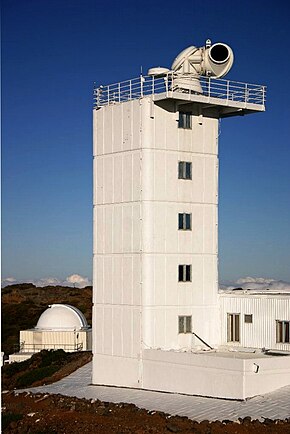
The Very Large Telescope (VLT) is a facility operated by the European Southern Observatory, located on Cerro Paranal in the Atacama Desert of northern Chile. It consists of four individual telescopes, each equipped with a primary mirror that measures 8.2 meters in diameter. These optical telescopes, named Antu, Kueyen, Melipal, and Yepun, are generally used separately but can be combined to achieve a very high angular resolution. The VLT array is also complemented by four movable Auxiliary Telescopes (ATs) with 1.8-meter apertures.

Subaru Telescope is the 8.2-metre (320 in) telescope of the National Astronomical Observatory of Japan, located at the Mauna Kea Observatory on Hawaii. It is named after the open star cluster known in English as the Pleiades. It had the largest monolithic primary mirror in the world from its commissioning until the Large Binocular Telescope opened in 2005.
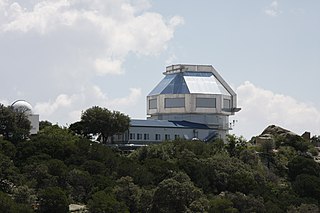
The WIYN Observatory is owned and operated by the WIYN Consortium. Its 3.5-meter telescope is the second largest optical telescope at Kitt Peak National Observatory in Arizona. Most of the capital costs for the observatory were provided by the University of Wisconsin–Madison, Indiana University, and Yale University, while the National Optical Astronomy Observatory (NOAO) provides most of the operating services. The NOAO is an institution of the United States; it is the national optical observatory program and supports a collection of ground-based telescopes at Kitt Peak as well as other locations.
The Swedish Vacuum Solar Telescope was a 47.5 cm solar telescope on La Palma in the Canary Islands. It was removed on 28 August 2000, and has been superseded by the Swedish 1-m Solar Telescope.

The Giant Magellan Telescope is a 25.4-meter, ground-based, extremely large telescope under construction at Las Campanas Observatory in Chile's Atacama Desert. Commissioning is anticipated in the early 2030s. Once complete, the Giant Magellan will be the largest Gregorian telescope ever built observing in optical and mid-infrared light. The telescope uses seven of the world’s largest mirrors to form a light collecting area of 368 square meters.
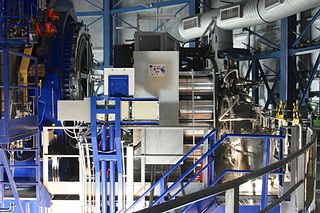
The Multi-Unit Spectroscopic Explorer (MUSE) is an integral field spectrograph installed at the Very Large Telescope (VLT) of the European Southern Observatory (ESO). It operates in the visible wavelength range, and combines a wide field of view with a high spatial resolution and a large simultaneous spectral range. It is specifically designed to take advantage of the improved spatial resolution provided by adaptive optics, offering diffraction-limited performance in specific configurations. MUSE had first light on the VLT’s Unit Telescope 4 (UT4) on 31 January 2014.

The Mercator Telescope is a 1.2 m telescope at the Observatorio del Roque de Los Muchachos on La Palma. It is operated by the Katholieke Universiteit Leuven, Belgium, in collaboration with the Observatory of the University of Geneva and named after Gerard Mercator, famous cartographer.
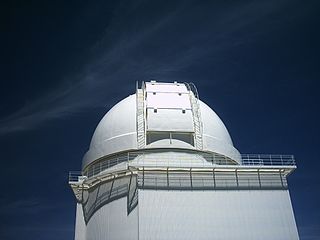
The Calar Alto Observatory is an astronomical observatory located in Almería province in Spain on Calar Alto, a 2,168-meter-high (7,113 ft) mountain in the Sierra de Los Filabres range.
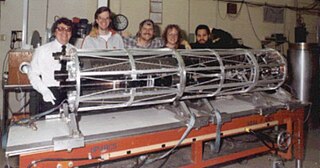
The Multi-spectral solar telescope array, or MSSTA, was a sounding rocket payload built by Professor A.B.C. Walker, Jr. at Stanford University in the 1990s to test EUV/XUV imaging of the Sun using normal incidence EUV-reflective multilayer optics. MSSTA contained a large number of individual telescopes, all trained on the Sun and all sensitive to slightly different wavelengths of ultraviolet light. Like all sounding rockets, MSSTA flew for approximately 14 minutes per mission, about 5 minutes of which were in space—just enough time to test a new technology or yield "first results" science. MSSTA is one of the last solar observing instruments to use photographic film rather than a digital camera system such as a CCD. MSSTA used film instead of a CCD in order to achieve the highest possible spatial resolution and to avoid the electronics difficulty presented by the large number of detectors that would have been required for its many telescopes.
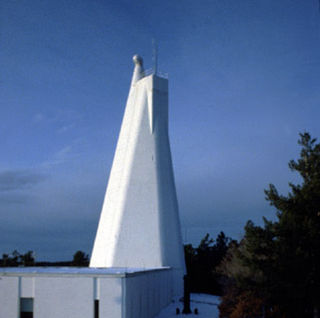
The Dunn Solar Telescope also known as the Richard B. Dunn Solar Telescope is a unique vertical-axis solar telescope, in Sunspot, New Mexico located at Sacramento Peak, New Mexico. It is the main telescope at the Sunspot Solar Observatory, operated by New Mexico State University in partnership with the National Solar Observatory through funding by the National Science Foundation, the state of New Mexico and private funds from other partners. The Dunn Solar Telescope specializes in high-resolution imaging and spectroscopy to help astrophysicists worldwide obtain a better understanding of how the Sun affects the Earth. Completed in 1969, it was upgraded with high-order adaptive optics in 2004 and remains a highly versatile astrophysical observatory which serves as an important test platform for developing new instrumentation and technologies. The Dunn Solar Telescope, located in Sunspot, New Mexico, is a vertical-axis solar telescope that specializes in high-resolution imaging and spectroscopy. It was completed in 1969 and received a significant upgrade with high-order adaptive optics in 2004.
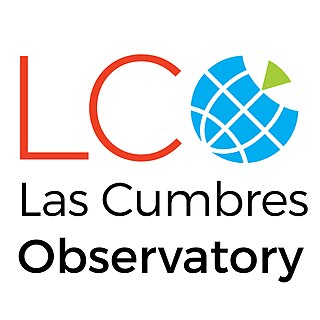
Las Cumbres Observatory (LCO) is a network of astronomical observatories run by a non-profit private operating foundation directed by the technologist Wayne Rosing. Its offices are in Goleta, California. The telescopes are located at both northern and southern hemisphere sites distributed in longitude around the Earth. For some astronomical objects, the longitudinal spacing of telescopes allows continuous observations over 24 hours or longer. The operating network currently consists of two 2 meter telescopes, nine 1 meter telescopes, and seven 40 cm telescopes, placed at six astronomical observatories. The network operates as a single, integrated, observing facility, using a software scheduler that continuously optimizes the planned observing schedule of each individual telescope.

The Daniel K. Inouye Solar Telescope (DKIST) is a scientific facility for studies of the Sun at Haleakala Observatory on the Hawaiian island of Maui. Known as the Advanced Technology Solar Telescope (ATST) until 2013, it was named after Daniel K. Inouye, a US Senator for Hawaii. It is the world's largest solar telescope, with a 4-meter aperture. The DKIST is funded by National Science Foundation and managed by the National Solar Observatory. The total project cost is $344.13 million. It is a collaboration of numerous research institutions. Some test images were released in January 2020. The end of construction and transition into scientific observations was announced in November 2021.

The Vacuum Tower Telescope is an evacuated-optics solar telescope located at the Teide Observatory on Tenerife in the Canary Islands. It is operated by the Kiepenheuer-Institut für Sonnenphysik (KIS).
The SOPHIEéchelle spectrograph is a high-resolution echelle spectrograph installed on the 1.93m reflector telescope at the Haute-Provence Observatory located in south-eastern France. The purpose of this instrument is asteroseismology and extrasolar planet detection by the radial velocity method. It builds upon and replaces the older ELODIE spectrograph. This instrument was made available for use by the general astronomical community October 2006.

Integral field spectrographs (IFS) combine spectrographic and imaging capabilities in the optical or infrared wavelength domains (0.32 μm – 24 μm) to get from a single exposure spatially resolved spectra in a bi-dimensional region. The name originates from the fact that the measurements result from integrating the light on multiple sub-regions of the field. Developed at first for the study of astronomical objects, this technique is now also used in many other fields, such bio-medical science and Earth remote sensing. Integral field spectrography is part of the broader category of snapshot hyperspectral imaging techniques, itself a part of hyperspectral imaging.

The Gemini Planet Imager (GPI) is a high contrast imaging instrument that was built for the Gemini South Telescope in Chile. The instrument achieves high contrast at small angular separations, allowing for the direct imaging and integral field spectroscopy of extrasolar planets around nearby stars. The collaboration involved in planning and building the Gemini Planet imager includes the American Museum of Natural History (AMNH), Dunlap Institute, Gemini Observatory, Herzberg Institute of Astrophysics (HIA), Jet Propulsion Laboratory, Lawrence Livermore National Lab (LLNL), Lowell Observatory, SETI Institute, The Space Telescope Science Institute (STSCI), the University of Montreal, University of California, Berkeley, University of California, Los Angeles (UCLA), University of California, Santa Cruz (UCSC), University of Georgia.

Interface Region Imaging Spectrograph (IRIS), also called Explorer 94 and SMEX-12, is a NASA solar observation satellite. The mission was funded through the Small Explorer program to investigate the physical conditions of the solar limb, particularly the interface region made up of the chromosphere and transition region. The spacecraft consists of a satellite bus and spectrometer built by the Lockheed Martin Solar and Astrophysics Laboratory (LMSAL), and a telescope provided by the Smithsonian Astrophysical Observatory (SAO). IRIS is operated by LMSAL and NASA's Ames Research Center.

The NIRSpec is one of the four scientific instruments flown on the James Webb Space Telescope (JWST). The JWST is the follow-on mission to the Hubble Space Telescope (HST) and is developed to receive more information about the origins of the universe by observing infrared light from the first stars and galaxies. In comparison to HST, its instruments will allow looking further back in time and will study the so-called Dark Ages during which the universe was opaque, about 150 to 800 million years after the Big Bang.

The 3.6m DevasthalOptical Telescope is a clear-aperture Ritchey–Chrétien telescope built by Aryabhatta Research Institute of Observational Sciences (ARIES) and is located at the Devasthal Observatory site near Nainital, Kumaon, India. ARIES operates another 1.3m telescope at the same location. The telescope was activated remotely on 31 March 2016 by Indian Prime Minister Narendra Modi and Belgian Prime Minister Charles Michel from Brussels. The telescope optics were built in collaboration with the Belgian firm Advanced Mechanical and Optical System (AMOS).

Synoptic Optical Long-term Investigations of the Sun (SOLIS) is a synoptic facility for solar observations over a long time frame that is funded by the National Science Foundation (NSF) and designed and built by the National Solar Observatory (NSO). It is operated by the NSO Integrated Synoptic Program (NISP). SOLIS is a single set of three instruments mounted on a common observing platform. The instruments are the 50 cm aperture Vector Spectromagnetograph (VSM), the 8 mm aperture Integrated Sunlight Spectrometer (ISS), and the 14 cm aperture Full-Disk Patrol (FDP). The VSM telescope is a quasi-Ritchey-Chretien design with a primary mirror operating at f/1.6. The ~ 400 W of solar light from the primary is reflected by a secondary mirror fabricated from a single silicon crystal. The final f/6.6 full-disk solar image is focused on a spectrograph slit that is cooled by a flow of chilled water-propylene glycol solution. The mirrors are coated with protected silver. To improve the internal seeing, the VSM is sealed by 74 cm diameter, 6 mm thick fused silica window. Originally, it was filled with helium at about ambient pressure and temperature. In 2014, helium was replaced by nitrogen due to the increasing cost of helium. Due to this change, the image sharpness was slightly degraded.
